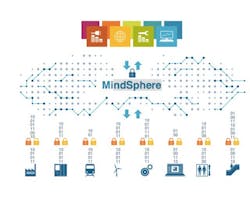With greater levels of attention being focused on edge computing over the past year, discussions about cloud computing have moved out of the forefront of the Industrial Internet of Things (IIoT). But that doesn't mean the cloud has been relegated to the past. Even as edge computing applications move more front and center in IIoT applications, the cloud will still play a critical role—particularly in analysis.
This analysis role for cloud computing was highlighted by Siemens recently when it announced its plan to integrate IBM’s Watson and other analytics tools powered by Cognos Analytics into its MindSphere cloud-based operating system. MindSphere, which was introduced at Hannover Messe last spring, is designed to improve the efficiency of production systems through the acquisition and analysis of large quantities of production data.
Two distinct goals are behind the incorporation of IBM technologies into MindSphere. This first of these is to provide additional visualization and dashboards. The second is to deliver analytics tools via APIs (application programming interfaces) for app-developers and data analysts.
The cognitive analytics provided by Watson are expected to help MindSphere users access and analyze data from sensors to “identify hidden connections in the huge amounts of data generated by production equipment,” said Siemens in its release announcing the Watson connection to MindSphere. More specifically, IBM’s analytics tools are expected to help industrial users in three ways:
- Boost operational performance and reduce downtime by bringing intelligence to production equipment.
- Use data from connected machines to predict anomalies and failure patterns and to initiate corrective measures.
- Improve product quality and yield using quality analytics that helps to detect the conditions that contribute to process failure and quality issues.
At the 2017 ARC Forum held earlier this month, Jagannath Rao, senior vice president of data services for Siemens USA, said Siemens currently has 30 customers using MindSphere. In his presentation, he pointed to two industrial production case examples. One of these instances involves machine monitoring for a major soft drink producer. The beverage manufacturer is using MindSphere as an IoT system for predictive maintenance on 150 motors in machines distributed throughout its production facility. In addition to providing the company with global access to the data from these motors, it has also reportedly increased asset uptime through better failure predictions.
The other example cited by Rao involves a national steel company that is also using MindSphere to monitor its fleet of motors. According to Rao, MindSphere is enabling the steel company to visualize its fleet of motors and has helped reduce downtime for all motor applications.
Rao pointed out that MindSphere is comprised of three layers: MindApps, MindSphere and MindConnect. MindApps are apps from Siemens and partners that are used to deliver asset transparency and analytical insights. The MindSphere operating system itself is the interface used to create customer-specific apps and works on a variety of cloud infrastructures including SAP, AtoS and Microsoft Azure. MindConnect offers secure and encrypted data communication to deliver plug–and-play connection of both Siemens and third-party products to the Mindsphere OS.
Siemens has focused a great deal of work on making all three of these layers open, said Rao. He clarified his use of the term “open” by saying these layers are “not just open sourced, but truly open.”
Highlighting the strengths of MindSphere for IIoT applications, Rao noted Siemens' installed base of more than 100 million devices (including 30 million automated systems) already connected to MindSphere, the ability to transfer specific domain expertise into vertical-specific analytical applications, digital twin capabilities for optimized engineering and maintenance, and the OS’s plug-and-play connectivity for easy connection of assets without coding.
Rao added that, to help end users digitalize their operations using MindSphere, Siemens offers a deep-dive workshop to identify specific use cases, helps them implement one of the identified cases with a technical proof of concept (PoC), and provides ongoing support after the PoC to maximize the benefits from MindSphere.
About the Author
David Greenfield, editor in chief
Editor in Chief

Leaders relevant to this article:
